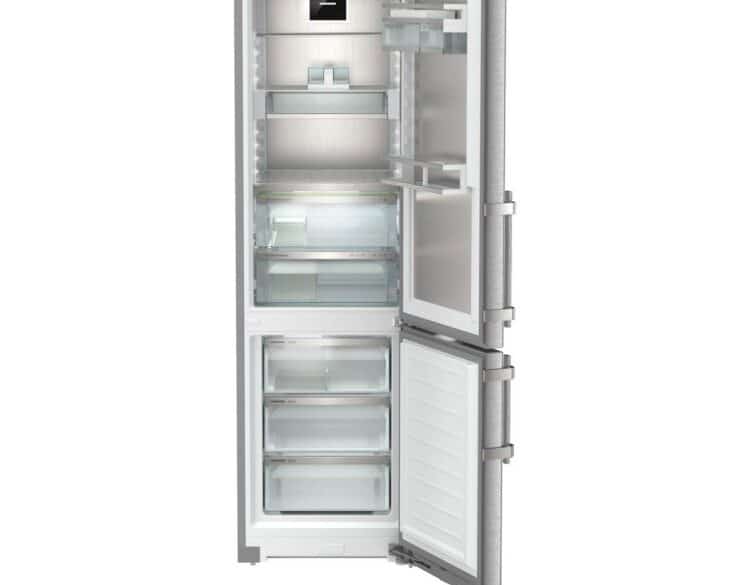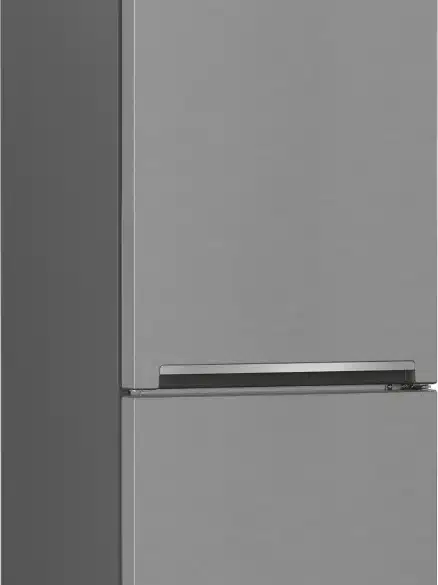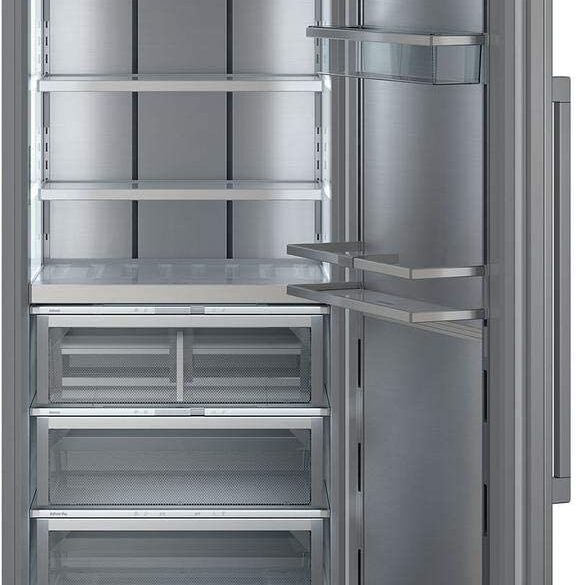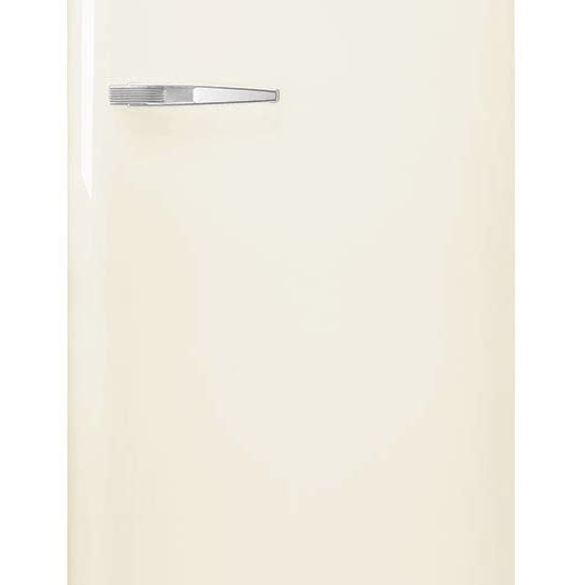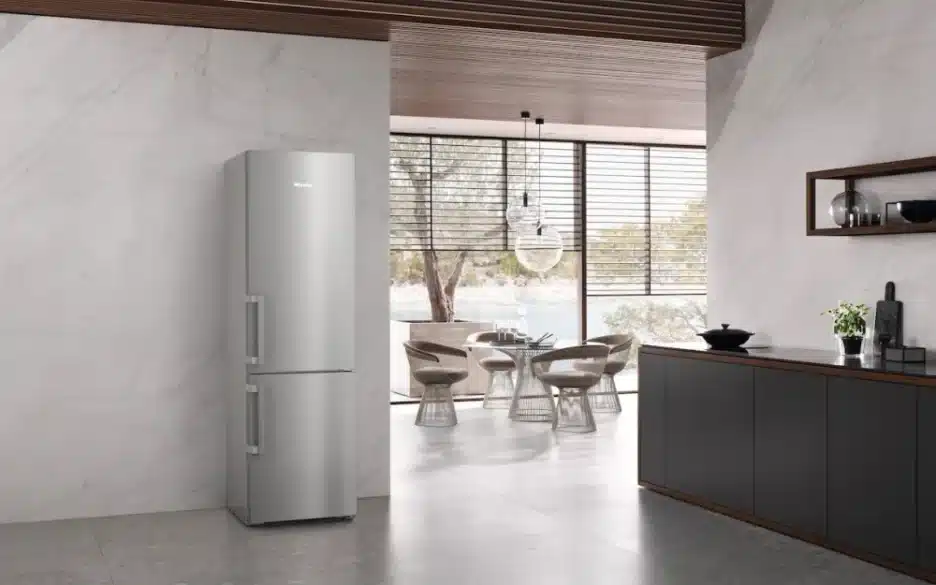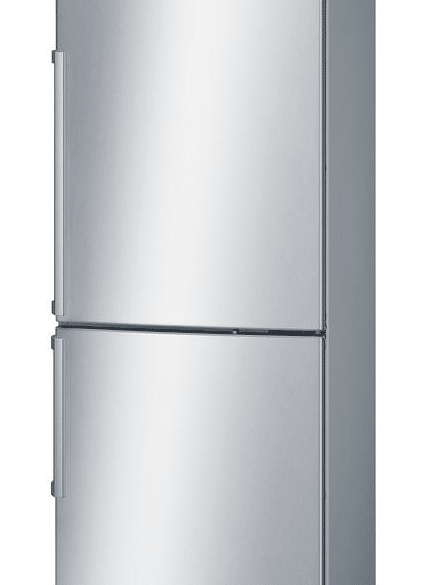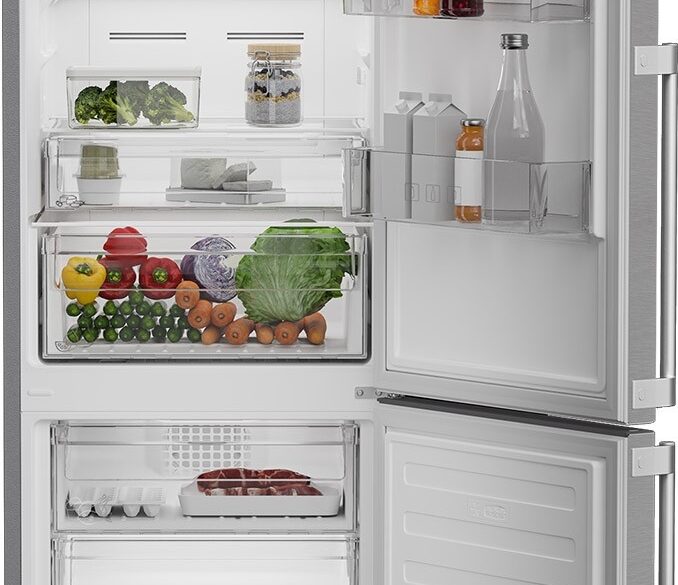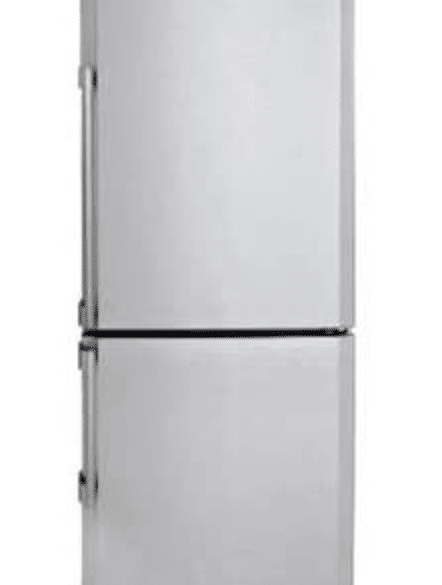Refrigerators use a lot of energy, most of which comes from fossil fuels. Here are our top picks for energy efficient refrigerators that use more eco-friendly refrigerant and have additional sustainability features.
Table of Contents
Refrigerators are one of the more energy-hungry items in a household, so it’s no surprise that many manufacturers have made considerable efforts to reduce energy consumption and improve performance. Even the more economical models tend to be pretty decent in terms of basic energy efficiency, while higher-end models often have specific measures to conserve extra power as needed.
You might also be interested in these articles:
Our top picks
Let’s get into our top picks for the most climate-friendly refrigerators. Curious about how we rate products? Click here to view our methodology, which at its core, is about voting with our dollars to fight climate change.
- Super quiet
- Lots of space (12.7 cu. ft.)
- Stainless steel exterior and interior back wall
- Can move shelves around
- Energy saving, Party, Night, and Sabbath modes
- Fresh air charcoal filter
- Replaceable door seal to extend life!
- Expensive
- No WiFi or smart connectivity
Annual energy use: 370 kWh
Refrigerant/coolant: R600a
Measurements: 23.5 inches wide, 79.31 inches high, 26.5 inches deep
Capacity: 12.7 cu. ft.
Certifications: Star-K Certified Sabbath Mode, ENERGY STAR®, ISO 9001, ISO 14001, RoHS
- Energy efficient bottom freezer refrigerator
- Made by a sustainable company
- Eco-friendlier coolant
- Super quiet!
- White and stainless steel options
- No Sabbath mode
- No WiFi connectivity
- Less established brand in the US (but well established in Europe)
Annual energy use: 360 kWh/yr (Energy Star; Beko says 300 kWh/yr)
Refrigerant/coolant: R600a
Measurements: 23.625 inches wide, 67.6875 inches tall, 26.375 inches deep
Capacity: 11.4 cu. ft.
Certifications: ENERGY STAR®, REACH, RoHS
The Beko BFBF2414 24-Inch Counter-Depth Bottom-Freezer Refrigerator is a great choice for an attractive, more affordable, sustainable fridge-freezer that is super quiet (just 39 dBA). This refrigerator even earned the ENERGY STAR® Most Efficient and Emerging Tech Award, partly because it uses Active Fresh Blue Light technology to better preserve the nutrient content and taste of fruits and vegetables.
This bottom freezer refrigerator includes:
- 3 Shelves and 1 crisper drawer
- Wine Rack
- NeoFrost™ for rapid cooling and humidity control
- Theater Lighting (LEDs)
- Ice Maker
- Fingerprint-free Stainless Steel option.
Beko is part of Arçelik, a Turkish company and one of the largest household appliance manufacturers in Europe. Beko has been in business for more than 30 years in the UK and was new to the American appliance sector in 2016. It has quickly become a go-to brand and a reliable, slightly more affordable alternative to Bosch.
Beko’s parent company is carbon neutral in global production plants as of 2019. It has also been recognized as a “Top Impact Company” for efficient use of resources and circular economy solutions and has been an Industry Leader in the Dow Jones Sustainability Index (DJSI) in Household Durables Category for two consecutive years (and included in the index for four consecutive years).
Beko won the 2021 ENERGY STAR® Sustained Excellence Award for the third consecutive year and is the first home appliance brand to be honored by the EPA every year in business in America.
- Very low energy use!
- Super quiet
- Very tall and striking (a real statement piece!)
- Cold air circulates well, keeping even door items cold
- Very expensive!
- No separate door for the freezer means greater loss of cool air
Annual energy use: 305 kWh
Refrigerant/coolant: R600a
Measurements: 29.69 inches wide, 83.75 inches tall, 24 inches deep
Capacity: 15 cu. ft.
Certifications: Star-K Certified Sabbath Mode, ENERGY STAR®, ISO 9001, ISO 14001, RoHS
Free eBook: Simple Steps to a Greener Home
Concerned about climate change? Learn actionable tips for making each room in your home greener.
"*" indicates required fields

- Looks great – lots of color options!
- Exceptionally energy efficient!
- Made by a sustainable company
- Uses low GWP potential coolant
- A bit deeper than most counter depth models
- Expensive
- Imported
- Not as much space as the Liebherr models
Annual energy use: 230 kWh
Refrigerant/coolant: R600a
Measurements: 23.625 inches wide, 57.5 inches tall, 27.5 inches deep
Capacity: 9.92 cu. ft.
Certifications: Energy Star, RoHS, REACH, ISO 9001, ISO 14001, OHSAS 18001
Smeg’s 24-Inch 50’s Style Refrigerator is attractive, energy efficient, and made by an Italian company demonstrating an impressive commitment to sustainability and environmental stewardship.
Smeg is very selective about its materials, favoring steel, glass, aluminum and brass, because these are easier to recycle.
This refrigerator offers the following:
- Small icebox
- Interior LED light
- 1 bottle rack and 1 fixed glass shelf
- 1 fruit and vegetable container
- 1 dairy box and 2 egg bins
- 2 adjustable covered bins in the door
- 2 bottle storage bins and 4 adjustable bins.
- Big capacity!
- Eco-friendlier coolant
- Very energy efficient for size
- WiFi, smart connectivity
- Sabbath mode
- Automatic defrost
- Energy Star Most Efficient 2024
- Not ADA compliant
- More expensive than WiFi-free models
Annual energy use: 370 kWh
Refrigerant/coolant: R600a
Measurements: 23.635 inches wide, 79.375 inches tall, 23.635 inches deep
Capacity: 13.21 cu. ft.
Certifications: Energy Star, Sabbath
Miele KFN4799DDE is a 24-inch freestanding refrigerator with bottom freezer. This smart, WiFi connected, energy efficient refrigerator boasts a massive 13.21 cubic feet of capacity, largely thanks to a few more inches depth than most 24-inch wide models.
The Miele also includes:
- Ice Maker
- NoFrost Defrost
- DailyFresh Drawer
- Miele@home
- SoftClose Doors
- DynaCool Temperature Control
- Dishwasher-Safe Shelves
- Flexiboard Shelf
- Door Lock & Alarm
- LED Lighting
- Sabbath Mode.
- Compact size
- Sustainable company
- Eco-friendly coolant
- Slightly shallower, skinnier model
- ADA compliant
- No Sabbath mode
- No WiFi connectivity
- More expensive than similar sized models
Annual energy use: 357 kWh
Refrigerant/coolant: R600a
Measurements: 23.5 inches wide, 78.875 inches tall, 23.875 inches deep
Capacity: 11 cu. ft.
Certifications: Energy Star
The Bosch B11CB50SSS 24-Inch Refrigerator is a great choice for city dwellers who want to keep resource use low. This fabulous refrigerator easily fits smaller spaces and is more likely to fit your building’s elevator and narrower hallways and doors.
This model doesn’t have an ice maker or water filter, but it is ADA compliant, which many other models aren’t.
- Really well lit interior
- Excellent climate control
- Quiet
- Attractive, slim and tall design
- Eco-friendly company
- Reversible door hinge
- Higher energy use than Liebherr, Smeg, and Bosch models
Annual energy use: 286 kWh
Refrigerant/coolant: R600a
Measurements: 23.4375 inches wide, 72.5 inches tall, 24.4375 inches deep
Capacity: 11.43 cu. ft.
Certifications: Energy Star
Blomberg is another brand to look for. It was the 2021 ENERGY STAR® Partner of the Year for the third year in a row and manufactures its refrigerators, which are at least 85 percent recyclable, in factories that are ISO 14001 certified. That means the company is mindful of the safe and responsible use of materials, energy, and natural resources.
Blomberg also claims that its refrigerators are built with 99.9 percent lead-free materials and are 100 percent free from ozone-depleting greenhouse gases.
This refrigerator is a little shorter and slightly deeper than its predecessor. So, if you’re replacing the Blomberg below with the 1046, make sure it fits your space.
This refrigerator boasts:
- Duo-Cycle Cooling
- Freezer Storage Bins
- Interior LED Lighting
- Reversible Door
- 3 Safety Glass Shelves
- Door Alarm
- Ice Cube Tray
- Energy Star® Qualified.
- Really well lit interior
- Excellent climate control
- Quiet
- Attractive, slim and tall design
- Eco-friendly company
- Reversible door hinge
- Higher energy use than Liebherr, Smeg, and Bosch models
Annual energy use: 395 kWh
Refrigerant/coolant: R600a
Measurements: 23.4 inches wide, 72.5 inches tall, 26.5 inches deep
Height: 72 ½ Inch
Capacity: 11.35 cu. ft.
Certifications: Energy Star
This is an older model of the 1046 above and a little cheaper as a result. It’s still a great choice and more energy efficient than similarly sized refrigerators.
Free eBook: Simple Steps to a Greener Home
Concerned about climate change? Learn actionable tips for making each room in your home greener.
"*" indicates required fields

Beyond Energy Efficiency
Energy efficiency isn’t the only measure by which to judge the eco-friendliness of a refrigerator. Unfortunately, most companies are not up front about the type of coolant they use, which, in the US, likely means they’re still using hydrofluorocarbons (HFCs). Many refrigerators are also hard to repair and built to become obsolete in just a few years, after which they are hard to recycle due to how they’re put together.
As such, some Energy Star refrigerators may actually be worse for the environment than those that use a little more energy each year!
So, while conscious consumers are wise to account for energy efficiency when choosing a new fridge, it’s also smart to check which kind of coolant the manufacturer uses and how the company approaches sustainability overall.
Coolants in Refrigerators
Companies that don’t use chlorofluorocarbons (CFCs), hydrochlorofluorocarbons (HCFCs), or HFCs tend to clearly advertise this fact. These companies include Bosch and GE. Indeed, GE was the first company to apply to the EPA for approval to use isobutane as a coolant instead of HCFCs or HFCs back in 2011.
After approval, GE launched the first HFC-free refrigerator in the US, the built-in Monogram 30-inch ZIK30GNHII Refrigerator (discontinued)) with an optional glass door and cyclopentane as the insulating foam. Miele’s refrigerators are also free from CFCs and HFCs, with the company instead using the same as Bosch and GE (isobutane and pentane).
These substances are easily processed when the time comes to recycle your appliance and are far more environmentally friendly than CFCs and HFCs. Also, all of GE’s appliances and components are labelled for recycling.
Despite GE’s achievement in getting EPA approval for isobutane, other manufacturers have mostly failed to follow suit. Isobutane has been widely used in household refrigerators in Europe and parts of Asia for several years, but HFCs and HCFCs remain redolent in US refrigerators. Things are starting to change, thanks to a phase out of HCFCs and HFCs that began in 2019. California has already entirely banned HFCs.
Free eBook: Simple Steps to a Greener Home
Concerned about climate change? Learn actionable tips for making each room in your home greener.
"*" indicates required fields

Liebherr is a German company that makes HFC-free refrigerators that perform well. The company’s refrigerators are some of my top picks at Leaf Score, and Liebherr is rare in that it earns a Leaf Score of 5 for some of its refrigerator models (Smeg also gets 5 leaves for some).
In 1993, Liebherr became the first manufacturer to convert their entire appliance range to HCFC/CFC-free refrigerants and Liebherr Appliances in North America was one of the first refrigeration manufacturers worldwide to be fully RoHS compliant by restricting the use of hazardous substances.
Liebherr also use environmentally-friendly powder coatings without using any solvents when finishing their sheet metals, and heat generated during manufacturing processes is recycled as heating energy for their offices and production sites. They also label the plastic components in products to ensure easy and optimum recycling, and all their production sites are certified to the international quality standard ISO 9001 and to the international environmental management standard ISO 14001.
EcoCool is a newer company offering refrigerator and freezer models that are impressively energy efficient. So much so that they can be run on a single solar panel, making them an excellent option as a refrigerator for a tiny home, boat, cabin, or other smaller household.
Frigidaire makes some of the most economical energy-efficient refrigerators and include features such as a powered-down mode for when you’re away for a few days or longer. Higher-end models such as Epicure French offer the ability to set different temperatures for different shelves. Indeed, one Epicure model consumes less energy than a 75W light bulb.
